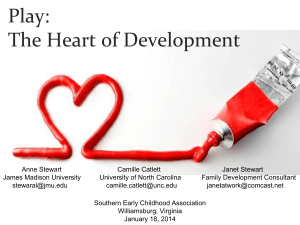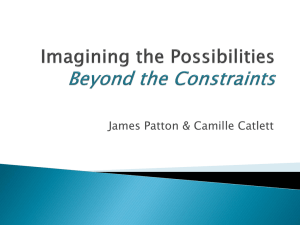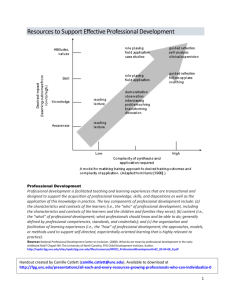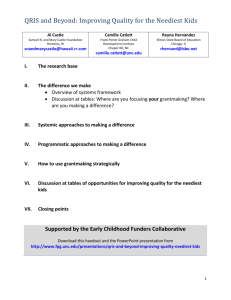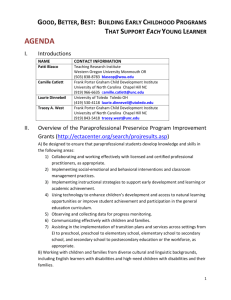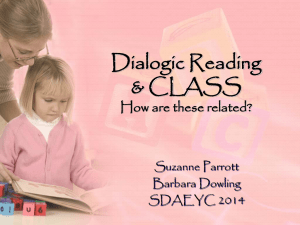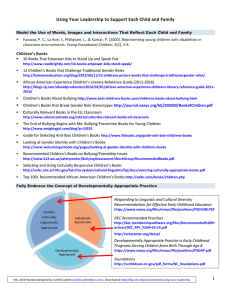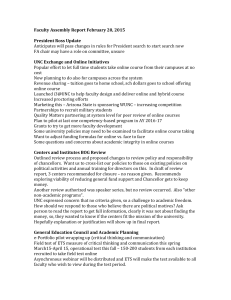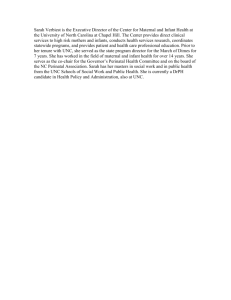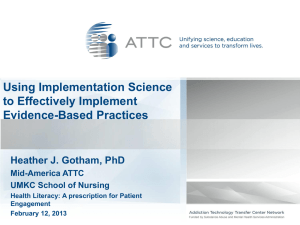Connecting the Smallest Dots handout
advertisement
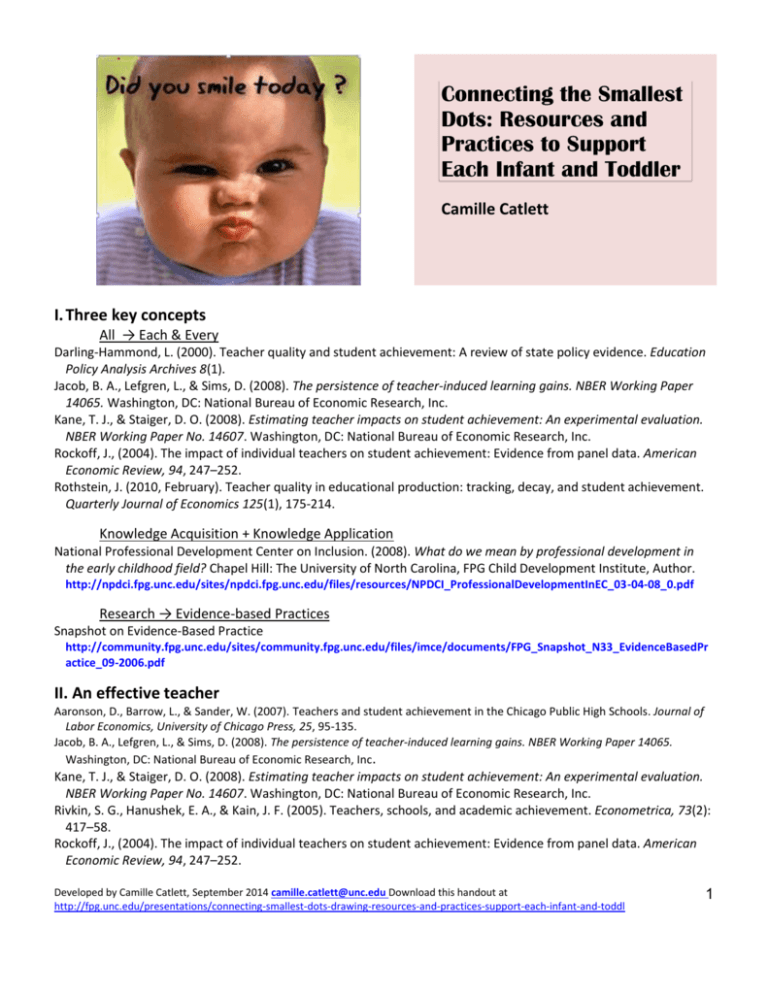
Connecting the Smallest Dots: Resources and Practices to Support Each Infant and Toddler Camille Catlett I. Three key concepts All → Each & Every Darling-Hammond, L. (2000). Teacher quality and student achievement: A review of state policy evidence. Education Policy Analysis Archives 8(1). Jacob, B. A., Lefgren, L., & Sims, D. (2008). The persistence of teacher-induced learning gains. NBER Working Paper 14065. Washington, DC: National Bureau of Economic Research, Inc. Kane, T. J., & Staiger, D. O. (2008). Estimating teacher impacts on student achievement: An experimental evaluation. NBER Working Paper No. 14607. Washington, DC: National Bureau of Economic Research, Inc. Rockoff, J., (2004). The impact of individual teachers on student achievement: Evidence from panel data. American Economic Review, 94, 247–252. Rothstein, J. (2010, February). Teacher quality in educational production: tracking, decay, and student achievement. Quarterly Journal of Economics 125(1), 175-214. Knowledge Acquisition + Knowledge Application National Professional Development Center on Inclusion. (2008). What do we mean by professional development in the early childhood field? Chapel Hill: The University of North Carolina, FPG Child Development Institute, Author. http://npdci.fpg.unc.edu/sites/npdci.fpg.unc.edu/files/resources/NPDCI_ProfessionalDevelopmentInEC_03-04-08_0.pdf Research → Evidence-based Practices Snapshot on Evidence-Based Practice http://community.fpg.unc.edu/sites/community.fpg.unc.edu/files/imce/documents/FPG_Snapshot_N33_EvidenceBasedPr actice_09-2006.pdf II. An effective teacher Aaronson, D., Barrow, L., & Sander, W. (2007). Teachers and student achievement in the Chicago Public High Schools. Journal of Labor Economics, University of Chicago Press, 25, 95-135. Jacob, B. A., Lefgren, L., & Sims, D. (2008). The persistence of teacher-induced learning gains. NBER Working Paper 14065. Washington, DC: National Bureau of Economic Research, Inc. Kane, T. J., & Staiger, D. O. (2008). Estimating teacher impacts on student achievement: An experimental evaluation. NBER Working Paper No. 14607. Washington, DC: National Bureau of Economic Research, Inc. Rivkin, S. G., Hanushek, E. A., & Kain, J. F. (2005). Teachers, schools, and academic achievement. Econometrica, 73(2): 417–58. Rockoff, J., (2004). The impact of individual teachers on student achievement: Evidence from panel data. American Economic Review, 94, 247–252. Developed by Camille Catlett, September 2014 camille.catlett@unc.edu Download this handout at http://fpg.unc.edu/presentations/connecting-smallest-dots-drawing-resources-and-practices-support-each-infant-and-toddl 1 Become a Skilled Observer and Objective Describer of What You See Print Forman, G., & Hall, E. (2005). Wondering with children: The importance of observation in early education. Early Childhood Research and Practice, 7(2). http://ecrp.uiuc.edu/v7n2/forman.html Audiovisual Early Intervention Videos http://www.cde.state.co.us/resultsmatter/RMVideoSeries_EarlyIntervention.htm#top Monkey Business Illusion https://www.youtube.com/watch?v=IGQmdoK_ZfY Observing Young Children http://www.easternct.edu/cece/e-clips_observation.html Pathways Awareness Foundation Motor Development Videos http://www.youtube.com/user/PathwaysAwareness Results Matter Video Library/Clips for Practicing Observation, Documentation and Assessment Skills http://www.cde.state.co.us/resultsmatter/RMVideoSeries.htm#01 Web Common Observation Strategies http://www.heartland.edu/documents/heip/faculty/HandoutCommonObservationStrategies.pdf Observation Toolkit for Mental Health Consultants http://www.ecmhc.org/observation_toolkit.html Use Evidence-Based Practices to Improve Quality Evidence National Professional Development Center on Inclusion. (2011). Research synthesis points on quality inclusive practices. Chapel Hill: The University of North Carolina, FPG Child Development Institute, Author. http://npdci.fpg.unc.edu/resources/articles/NPDCI-ResearchSynthesisPointsInclusivePractices-2011 Assistive Technology (AT) AT for Infants/Toddlers http://www.scoe.net/seeds/resources/at/atInfants.html Assistive Technology for Infants, Toddlers, and Young Children http://www.nectac.org/topics/atech/atech.asp CONNECT Module 5: Assistive Technology http://community.fpg.unc.edu/connect-modules/learners/module-5 Curriculum Map: Assistive Technology http://www.kirkwood.edu/pdf/uploaded/1163/ece_103_at_early__childhood__program__curr__outline%5B1%5D.pdf Using Assistive Technology (AT) to Promote Literacy in Infants and Toddlers http://tnt.asu.edu/files/Dec2012Newsletter.pdf Universal Design for Learning (UDL) Conn-Powers, M., Cross, A.F., Traub, E.K., & Hutter-Pishgahi, L. (2006, September). The universal design of early education: Moving forward for all children. Beyond the Journal: Young Children on the Web. http://journal.naeyc.org/btj/200609/ConnPowersBTJ.pdf Bertling, J., Darrah, M., Lyon, D., & Jackson, S. (n.d.) Early childhood building blocks: Universal design for learning in early childhood inclusive classrooms. http://rec.ohiorc.org/orc_documents/orc/recv2/briefs/pdf/0018.pdf Building Inclusive Childcare Universal Design for Learning video http://www.northampton.edu/Early-Childhood-Education/Partnerships/Building-Inclusive-Child-Care.htm National Center to Improve Practice (NCIP): Early Childhood Guided Tour http://www2.edc.org/NCIP/tour/toc.htm Embedded Instruction and Other Naturalistic Interventions CONNECT Module 1: Embedded Interventions http://community.fpg.unc.edu/connect-modules/learners/module-1/ Embedded Learning Opportunities (videos, PowerPoints) http://depts.washington.edu/hscenter/elo Embedded Instruction for Early Learning http://www.embeddedinstruction.net/ Scaffolding Strategies Campbell, P. H., Milbourne, S. A., & Kennedy, A. A. (2012). CARA’s kit for toddlers! Baltimore: Brookes. Center for Early Literacy Infant/Toddler Practice Guides for Practitioners http://www.earlyliteracylearning.org/pgpracts.php Center for Early Literacy Infant/Toddler Practice Guides for Families http://www.earlyliteracylearning.org/pgparents.php CONNECT Module 1: Embedded Interventions http://community.fpg.unc.edu/connect-modules/learners/module-1/ Developed by Camille Catlett, September 2014 camille.catlett@unc.edu Download this handout at http://fpg.unc.edu/presentations/connecting-smallest-dots-drawing-resources-and-practices-support-each-infant-and-toddl 2 Engage and Partner with Families Evidence Encouraging Meaningful Parent/Educator Collaboration: A Recent Review of Literature http://www.directionservice.org/cadre/pdf/EncouragingMeaningfulCollaborationJULY2011.pdf Family Engagement, Diverse Families, and Early Childhood Education Programs: An Integrated Review of the Literature http://www.naeyc.org/files/naeyc/file/research/FamEngage.pdf Family-Provider Relationships: A Multidisciplinary Review of High Quality Practices and Associations with Family, Child, and Provider Outcomes http://www.acf.hhs.gov/programs/opre/cc/childcare_technical/reports/family_provider_multi.pdf Fostering Parent and Professional Collaboration: Research Brief https://www.utoledo.edu/education/grants/partnerproject/focus/docs/Parent%20and%20Professional%20Collaboration %20Research%20Brief%20-%20Final.pdf Having Their Say: Parents Describe Why and How They are Engaged in Their Children’s Education http://www.parentinvolvementmatters.org/system_files/library/34.pdf Print Asking the Right Questions in the Right Ways: Strategies for Ethnographic Interviewing http://www.asha.org/Publications/leader/2003/030429/f030429b.htm School Readiness for Infants and Toddlers? http://www.naeyc.org/yc/article/school-readiness-for-infants-and-toddlers Supporting Parent and Caregiver Involvement in Early Literacy Practices with Young Children from Diverse Backgrounds and Abilities http://depts.washington.edu/hscenter/sites/default/files/01_15m_inclusion_inservice/08_family_ literacy/documents/family_literacy_research_brief.pdf Audiovisual CONNECT Module 3: Communication for Collaboration http://community.fpg.unc.edu/connect-modules/learners/module-3 CONNECT Module 4: Family-Professional Partnerships http://community.fpg.unc.edu/connect-modules/learners/module-4 Just Being Kids http://www.cde.state.co.us/resultsmatter/RMVideoSeries_JustBeingKids.htm#top Sharing Documentation with Families http://www.cde.state.co.us/resultsmatter/RMVideoSeries.htm#top Using Video to Celebrate Progress http://www.cde.state.co.us/resultsmatter/RMVideoSeries_EarlyIntervention.htm#top Using Video to Share with Family Members http://www.cde.state.co.us/resultsmatter/RMVideoSeries_EarlyIntervention.htm#top Web CSEFEL Family Tools http://csefel.vanderbilt.edu/resources/family.html CSEFEL Parent Training Modules http://csefel.vanderbilt.edu/resources/training_parent.html National Center on Parent, Family & Community Engagement http://eclkc.ohs.acf.hhs.gov/hslc/tta-system/family Preparing Educators to Engage Families http://www.hfrp.org/publications-resources/browse-our-publications/teaching-the-teachers-preparing-educators-toengage-families-for-student-achievement Protective Factors Framework http://www.cssp.org/reform/strengthening-families/the-basics/protective-factors TACSEI Backpack Connection Series http://www.challengingbehavior.org/communities/families.htm Developed by Camille Catlett, September 2014 camille.catlett@unc.edu Download this handout at http://fpg.unc.edu/presentations/connecting-smallest-dots-drawing-resources-and-practices-support-each-infant-and-toddl 3 Support Culturally and Linguistically Respectful and Responsive Practices Evidence Division for Early Childhood. (2010). Responsiveness to ALL children, families, and professionals: Integrating cultural and linguistic diversity into policy and practice. Los Angeles, CA: Author. http://dec.membershipsoftware.org/files/Position%20Statement%20and%20Papers/Position%20Statement_Cultural%20a nd%20Linguistic%20Diversity.pdf National Association for the Education of Young Children. (2009). Where we stand on responding to linguistic and cultural diversity: Recommendations for effective early childhood education. Washington, DE: Author. http://www.naeyc.org/files/naeyc/file/positions/diversity.pdf Print (2008). Dual language learners in early care and education settings. Zero to Three, 29(2), 52-53. http://main.zerotothree.org/site/DocServer/Dual_Language_Learners.pdf Early Dual Language Learning http://main.zerotothree.org/site/DocServer/29-1_Genesee.pdf Early Identification of Culturally and Linguistically Diverse Children (aged 0-5) http://www.nectac.org/~pdfs/pubs/earlyidmini.pdf Maschinot, B. (2008).The changing face of the United States: The influence of culture on early child development. Washington, DC: ZERO TO THREE. http://main.zerotothree.org/site/DocServer/Culture_book.pdf?docID=6921 AudioVisual Gonzalez-Mena, J. (1996). Diversity: Contrasting perspectives. Crystal Lake, IL: Magna Systems. http://learningseed.vidcaster.com/j7Dj/diversity-contrasting-perspectives/ Play & Motor Development: A Multicultural Perspective http://www.youtube.com/watch?v=ly6AxV1TVe8 Web Building Cultural Connections: Curriculum and Trainer’s Guide http://www.dhs.state.mn.us/main/groups/business_partners/documents/pub/dhs16_157281~2.pdf Colorín Colorado http://www.colorincolorado.org/ Cultural Competency: What It Is and Why It Matters http://www.californiatomorrow.org/media/ccompetecy.pdf Cultural Influences on Early Language and Literacy Teaching Practices http://main.zerotothree.org/site/DocServer/ZTT27-1_Parlakian.pdf?docID=11661 Linguistically and Culturally Relevant Early Childhood Environments http://eclkc.ohs.acf.hhs.gov/hslc/tta-system/culturallinguistic/Dual%20Language%20Learners/ecd/supportive_environments/Linguisticallyan.htm Multicultural Principles for Head Start Programs http://eclkc.ohs.acf.hhs.gov/hslc/hs/resources/ECLKC_Bookstore/PDFs/Revisiting%20Multicultural%20Principles%20for %20Head%20Start_English.pdf National Center for Children in Poverty http://www.nccp.org/ National Center on Cultural and Linguistic Responsiveness http://eclkc.ohs.acf.hhs.gov/hslc/tta-system/cultural-linguistic Reaching All Children: Understanding Early Care and Education Participation Among Immigrant Families http://www.clasp.org/publications/child_care_immigrant.pdf Strategies for Supporting All Dual Language Learners http://eclkc.ohs.acf.hhs.gov/hslc/tta-system/cultural-linguistic/docs/dll-strategies.pdf Supporting Parent and Caregiver Involvement in Early Literacy Practices with Young Children from Diverse Backgrounds and Abilities http://depts.washington.edu/hscenter/family-literacy-1 Overall Resources Baby Talk / Natural Resources CONNECT Modules http://community.fpg.unc.edu/ SCRIPT-NC http://scriptnc.fpg.unc.edu/ Developed by Camille Catlett, September 2014 camille.catlett@unc.edu Download this handout at http://fpg.unc.edu/presentations/connecting-smallest-dots-drawing-resources-and-practices-support-each-infant-and-toddl 4 Checklist of Effective Partnerships with Families Did You See It? What Should You See? YES NO Enhanced Communication Asking families open-ended questions about the people, places, and activities that are important to them Listening to families’ perspectives without sharing your own opinions first Learning about how families prefer to communicate (e.g., phone, email, in person) Using an interpreter to support interactions with family members who speak another language Learning and using key words and phrases in the languages of the children Seeking families’ input on topics when there are differences that need to be openly addressed Being persistent about communicating with each family, even when they have not been responsive thus far Demonstrating how disagreements or differences of opinion do not interfere with your commitment to the family and child High Expectations Asking families what they see as their child’s strengths Focusing on the child’s strengths and not just the child’s needs Asking families about goals for their child Involving families in all decisions about their child Celebrating with families as children meet new milestones Respect Asking families what is important to know about their culture, language(s), celebrations, and customs and showing genuine interest Listening to families with particular attention to insights and information about cultural and linguistic preferences and priorities Asking how you should address members of the family Asking families how they have been involved in their child’s program in the past and how they would like to be involved in the future Reflecting the cultures and languages of families in each classroom or program Commitment Holding meetings at times and places suited to the families’ needs and availability whenever possible Reflecting the cultures, language(s), celebrations, customs and values of the families in environments, interactions, and curriculum Discussing ways to find options that are responsive to families’ cultural values Developing and using a process for regularly soliciting and implementing input from families to inform program decisions Adapted from: CONNECT Module 4; Teaching at the Beginning: Partnering with Parents http://teachatb.org/partneringwithparents/; Language Castle http://www.languagecastle.com/2014/09/fast-5gamechangers-really-get-parents-dlls-engage/; NCLR Core Qualities for Successful Early Childhood Education Programs 5 6
